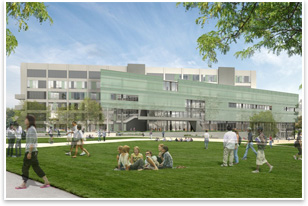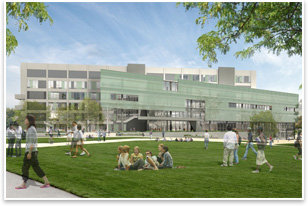Brain Research Helps Correlate Design with Value
New paradigm of measurement quantifies architects’ intuition
by Tracy Ostroff
Contributing Editor
 How do you . . . quantify the value of architecture? How do you . . . quantify the value of architecture?
Summary: Ontario, Calif.-based HMC Architects has recently hired a neuroscientist from the University of California, San Diego (UCSD) to study the neurological effects of lighting, sound, orientation, and architectural design in health-care environments. HMC wants to use this research to refine its production of health-care designs that maximize patient recovery and workplace productivity.
”Neuroscience provides a means for us to measure how the brain, body, and building interact," notes Eve Edelstein, PhD, a neuroscientist from UCSD who serves as HMC's senior vice president of research and design. "Neuroscience gives us the tools to understand how the engagement of our senses in architectural space influences our emotions, behavior, and health itself."
AIArchitect spoke with Edelstein about her work and its correlation with architecture. Trained in neuroscience and with an MArch, Edelstein has an extensive background as a university lecturer, scientist, and clinician. Her research in basic and clinical neuroscience provides the basis for looking at the influence of design features such as light, sound, and location on educational and health-care design outcomes.
Her responsibilities at HMC include laying the groundwork for translating biomedical and behavioral evidence into design and developing studies that measure the influence of specific HMC designs on client responses, such as student learning, navigation and memory; patient recovery; or overall client operations and satisfaction. Edelstein developed the first program of courses in neuroscience for architecture at the New School of Architecture and Design and is a visiting scholar at UCSD, where she teaches a senior seminar in neuroscience and architecture.
Q. How did you develop your relationship with HMC?
A. I had the fortune of being a principal investigator for the Latrobe Fellowship, where we demonstrated evidence-based practice models. The next step for me was to say: “Well, let me become deeply embedded in an architecture practice, so that we can now examine closely how a theoretical model and a practice model actually fit well into the practice of design.” HMC has been very supportive of me continuing the knowledge dissemination work and continuing pure research, which I’m doing at USCD. HMC President Randy Peterson, FAIA, said to me: “If one stops doing research, your knowledge becomes old.” So they encouraged me to continue doing my research with UCSD and also to explore with UCSD opportunities for collaborative efforts.
 Q. Who takes part in these discussions? Q. Who takes part in these discussions?
What we have launched grew out of the workshops from John Eberhard and the Latrobe Fellowship. The Academy of Architecture for Neuroscience Workshops, I believe, ran over the course of 2002 through about 2006. They brought together a group of interdisciplinary thinkers from across the country that included architects and designers, environmental psychologists, academic architects, practicing architects, with scientists from the scope and range of neuroscience—cognitive neuroscientists, behavioral scientists, neurophysiological scientists, and even scientists whose specialties were in the animal models of neuroscience. Over the course of those years, we had several workshops on health-care environments. We brought in specialists related to that work, and we had several workshops on education and the influence of neuroscience on environments for learning. We had a couple of workshops on spiritual environments and also workshops on laboratories and commercial environments. We looked at a very broad range of activities.
We looked for people who could contribute to that discussion and who were fascinated by that series of interdisciplinary efforts. From that came the idea for the wayfinding project that I have been working on at UCSD. UCSD sponsored me. And Professor Eduardo Macagno, of the Division of Biological Sciences, brought on board the Swartz Center for Computational Neuroscience [a Center of the Institute for Neural Computation, the University of California, San Diego] to explore—with me and the scientists at CALIT2—how the brain works as it is navigating and how architecture itself influences human responses. What CALIT2 has is this fabulous virtual cave, called the StarCAVE. So arising out of the discussions of the first health-care workshop on wayfinding, we devised an experiment to set up the technologies to enable us to look further forward and start asking these questions.
And that’s our motive: To use scientific methodologies and new technologies to quantify what we have intuitively suspected to be the case or experienced to be the case. It can be very difficult to argue for that intuition in a world where architects must be expected to be concerned about the bottom line and conveying the benefit of design options and changes that might have real costs and that might conflict with the many, many variables that have to be considered in design.
Q. How does your work inform the discussion about the value of architecture?
The question arises: “How do you create an ordering principle based on evidence that helps the client decide which of the many design options might be most valued?” To me, you can create a very simple paradigm where you say the input is the architectural environment in all its complexities, all of the features that architecture itself creates. The response to that is the human response in all of its complexities, from behavior and opinion and emotional response, to the types of responses environmental psychologists have been measuring for some decades, but now including some of the objective measures that have not been included to date. That’s where neuroscience offers an opportunity for us to understand the human response. The mind-brain-body link is now much more clearly understood than it ever was before, and technology has advanced so that we can examine it in a way that we were never able to examine it before.
 Now we can measure the human response, and at the same time we can measure the environmental input with new micro-technologies. We can start to go from the scale of a building and the scale of many people interacting to that building, to the scale of a room or an architectural feature such as how much light, or the quality of light that architectural openings allow into a space. We can start to measure that relative to actual biological responses and what the outcomes are when one is engaged in different environments. Now we can measure the human response, and at the same time we can measure the environmental input with new micro-technologies. We can start to go from the scale of a building and the scale of many people interacting to that building, to the scale of a room or an architectural feature such as how much light, or the quality of light that architectural openings allow into a space. We can start to measure that relative to actual biological responses and what the outcomes are when one is engaged in different environments.
The outcome measures are where we can start to quantify the true value of design, such as health outcomes in different environments and the behavioral and operational outcomes that can be compared to the benchmarks that every institution keeps in terms of its operational costs, quality of professional service, client/user satisfaction, and recruitment and retention of staff. Institutions collect this information all of the time, at a very gross level. By bringing everything down to this finer scale, we can start to better understand correlations that speak to the value and return on investment of design.
When we get to those levels of information gathering, we can go to our clients and say: “Here is the ordering principle, here is our expected outcome based on the evidence in the literature and the evidence that we have collected in our practice, and here is how we might examine your institution, your site, and your facility relative to these projected outcome measures and your needs.”
We can also say: “Here is where we think the biggest bang for the buck is and here’s what we think, based on the evidence, might be the most important things to attend to.” The health-care architects have been leaders in this push for evidence-based design. Their clients are often MD/PhDs trained in scientific methodologies and data analysis and understand the input human process and output and are asking architects for these correlations.
Q. What is the value of the evidence-based model?
A. One of the most beautiful outcomes of the 2005 Latrobe Fellowship effort was to demonstrate an evidence-based model. We did the cardiac response to different light because heart-rate variability is a sensitive indicator of not only health status and health risk, but it also tells us when the body is getting itself ready to engage in certain cognitive tasks. With the use of some beta test devices to measure the amount of light levels both in our experiment and in real architectural environments, we then drew a conclusion about what this pilot experiment demonstrated about how to pull together physiology and measurements of real facilities and consideration of outcomes. Kaiser-Permanente also put together a data mining example to show how this whole input human response output paradigm could be modeled with their own data set of outcomes in their hospital.
I think it is a wonderful model of how we can all go forward to really begin correlating design with value. We have real potential here to choose the best measurement for the client, the architectural facility being considered, and the outcome measure of most importance to that client. So it’s not an argument of one size fits all or that only one approach is the right approach. It’s an argument for combining the approaches, combining expertise broadly, selecting very carefully the best means to analyze the impact of design, and then finding the most appropriate vehicle for communicating that to the world at large. We have a mission both to share information and use it within our practices for our clients and for the greater good.
Q. Is evidence-based design an easier or harder sell in a tough economy?
A. Well, I think we’re all just learning what this economy means to all of us. I think I would have a crystal ball far greater than anybody else out there if I could make a definitive statement. But I think the move toward correlating input response with outcome gives us a vehicle for talking about the value of design, and I think in any economic environment that is terribly important. It’s a rare environment where we have enough money to do everything that we would love to do.
Architects have, for thousands of years perhaps, intuitively known the value of more amenable environments. There are many, many things that I’m sure we would all love to design, and we are often limited by budget as well as process, regulations, and time, so I’m very excited by the effort many different institutes are making to capture more of the human element in descriptions of how we should build. A great example of that is the Facility Guidelines for Healthcare Environments, which has incorporated much of our thinking, and there are many other institutions that are looking at how to quantify the human benefit.
| 

 How do you . . .
How do you . . . Q. Who takes part in these discussions?
Q. Who takes part in these discussions? Now we can measure the human response, and at the same time we can measure the environmental input with new micro-technologies. We can start to go from the scale of a building and the scale of many people interacting to that building, to the scale of a room or an architectural feature such as how much light, or the quality of light that architectural openings allow into a space. We can start to measure that relative to actual biological responses and what the outcomes are when one is engaged in different environments.
Now we can measure the human response, and at the same time we can measure the environmental input with new micro-technologies. We can start to go from the scale of a building and the scale of many people interacting to that building, to the scale of a room or an architectural feature such as how much light, or the quality of light that architectural openings allow into a space. We can start to measure that relative to actual biological responses and what the outcomes are when one is engaged in different environments.